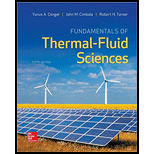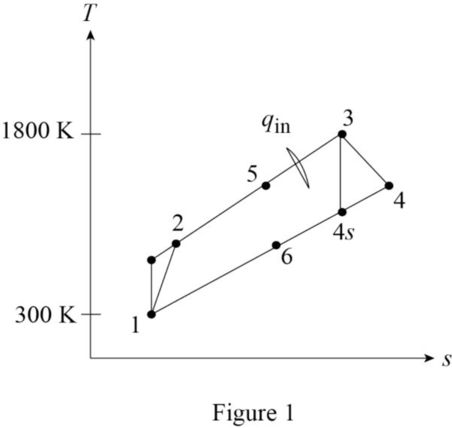
a)
The thermal efficiency and the required mass flow rate of helium when the isentropic efficiency is 100%.
a)
Explanation of Solution
Given:
Pressure ratio
Net power output
Effectiveness
Compressor inlet temperature
Turbine inlet temperature
Calculation:
Draw the

Refer Table A-2, “Ideal-gas specific heats of various common gases”, obtain the properties of the helium.
Calculate the temperature at state 2s
Calculate the temperature at state 4s
Calculate the temperature at state 5
Calculate the mass flow rate of the helium
Thus, the mass flow rate of the helium is
Calculate the thermal efficiency of the cycle
Thus, the thermal efficiency of the cycle is
b)
The thermal efficiency and the required mass flow rate of helium when the isentropic efficiency is 80%.
b)
Explanation of Solution
Calculation:
Calculate the temperature at state 2s
Calculate the temperature at state 2
Calculate the temperature at state 4s
Calculate the temperature at state 4
Calculate the temperature at state 5
Calculate the mass flow rate of the helium
Thus, the mass flow rate of the helium is
Calculate the thermal efficiency of the cycle
Thus, the thermal efficiency of the cycle is
Want to see more full solutions like this?
Chapter 9 Solutions
Fundamentals of Thermal-Fluid Sciences
 Elements Of ElectromagneticsMechanical EngineeringISBN:9780190698614Author:Sadiku, Matthew N. O.Publisher:Oxford University Press
Elements Of ElectromagneticsMechanical EngineeringISBN:9780190698614Author:Sadiku, Matthew N. O.Publisher:Oxford University Press Mechanics of Materials (10th Edition)Mechanical EngineeringISBN:9780134319650Author:Russell C. HibbelerPublisher:PEARSON
Mechanics of Materials (10th Edition)Mechanical EngineeringISBN:9780134319650Author:Russell C. HibbelerPublisher:PEARSON Thermodynamics: An Engineering ApproachMechanical EngineeringISBN:9781259822674Author:Yunus A. Cengel Dr., Michael A. BolesPublisher:McGraw-Hill Education
Thermodynamics: An Engineering ApproachMechanical EngineeringISBN:9781259822674Author:Yunus A. Cengel Dr., Michael A. BolesPublisher:McGraw-Hill Education Control Systems EngineeringMechanical EngineeringISBN:9781118170519Author:Norman S. NisePublisher:WILEY
Control Systems EngineeringMechanical EngineeringISBN:9781118170519Author:Norman S. NisePublisher:WILEY Mechanics of Materials (MindTap Course List)Mechanical EngineeringISBN:9781337093347Author:Barry J. Goodno, James M. GerePublisher:Cengage Learning
Mechanics of Materials (MindTap Course List)Mechanical EngineeringISBN:9781337093347Author:Barry J. Goodno, James M. GerePublisher:Cengage Learning Engineering Mechanics: StaticsMechanical EngineeringISBN:9781118807330Author:James L. Meriam, L. G. Kraige, J. N. BoltonPublisher:WILEY
Engineering Mechanics: StaticsMechanical EngineeringISBN:9781118807330Author:James L. Meriam, L. G. Kraige, J. N. BoltonPublisher:WILEY





